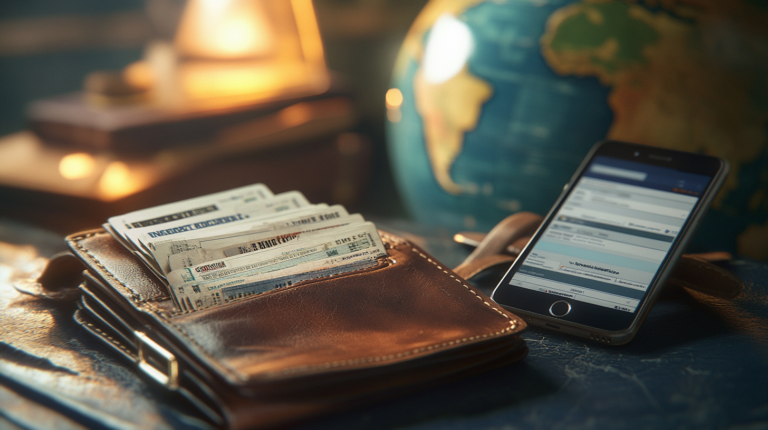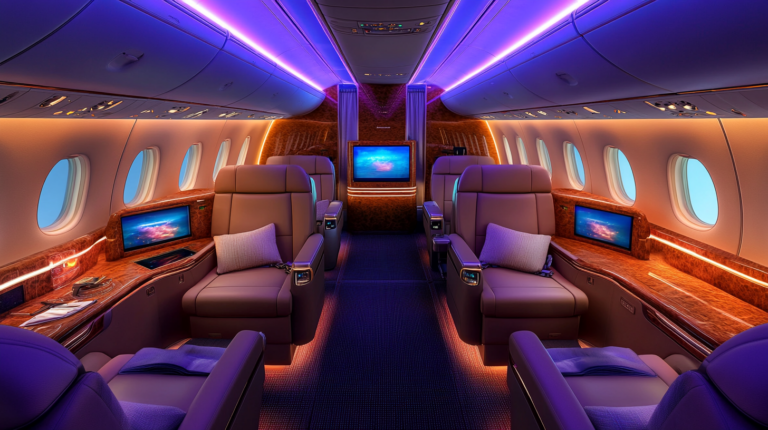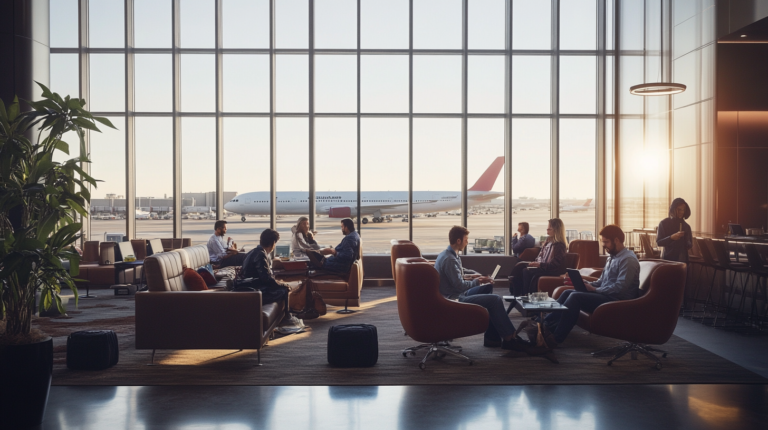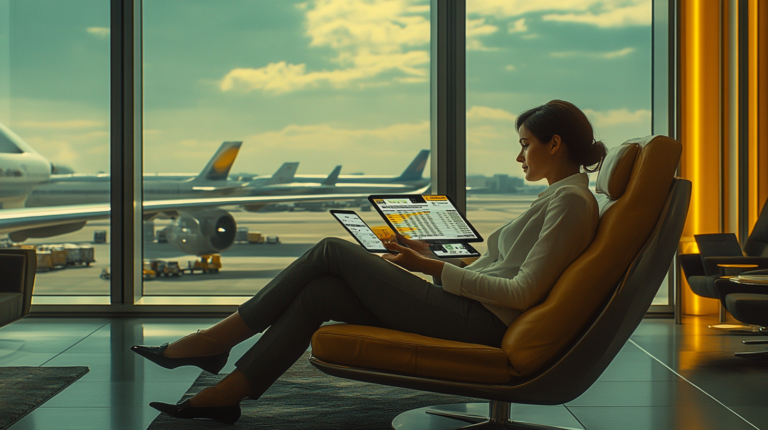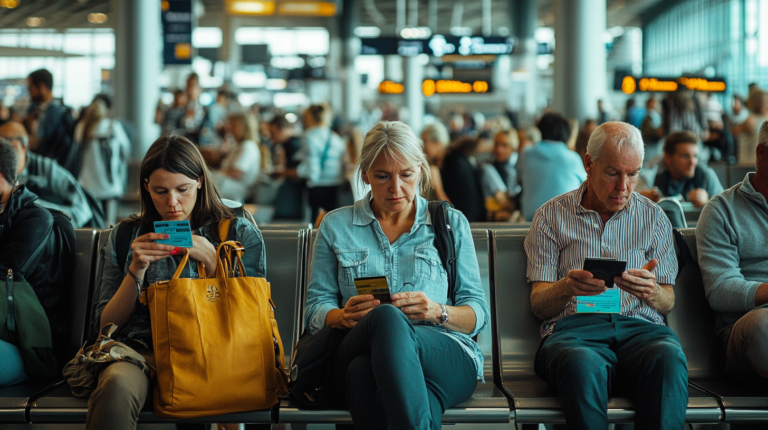Flying Naked: The Rise of Minimalist Travel
In an era where every inch of luggage space comes at a premium, a new travel trend is taking flight—literally. “Flying Naked” is not about shedding clothes at 30,000 feet, but rather about shedding the excess baggage that accompanies most journeys. This minimalist approach to travel emphasizes carrying only the essentials, often fitting everything into pockets or a small bag.
According to recent industry reports, airlines collected over $5 billion in baggage fees last year, according to airline industry reports, prompting many travelers to reevaluate what they pack. As airlines continually update baggage policies and increase fees, more travelers are embracing this concept to save money, reduce stress, and focus on the pure experience of travel.
Additionally, the environmental benefits of reducing luggage weight contribute to a smaller carbon footprint, aligning with the growing trend of eco-conscious travel practices.
Popularized through social media platforms like TikTok and Instagram—where the hashtag #FlyingNakedChallenge has garnered millions of views—”Flying Naked” has sparked a worldwide conversation among adventurers and budget travelers alike.
Videos showcasing tips and tricks for packing light have inspired others to reevaluate their packing habits. It challenges traditional notions of what is necessary when hitting the skies, promoting a philosophy of simplicity and flexibility. The trend’s catchy name and provocative nature have captured media attention, with major outlets featuring stories on how minimalist travel is redefining the industry.
But beyond the hype lies a practical solution to some of the most common frustrations in modern air travel, such as lengthy check-in times, lost luggage, and the stress of juggling heavy bags through crowded airports.
This article delves into the multifaceted world of “Flying Naked,” exploring its origins, appeal, and the various styles that have emerged within this movement. We’ll examine the benefits and drawbacks, provide practical tips and real-world examples for those curious about trying it out, and consider its implications for the future of travel.
From interviews with seasoned minimalists to insights from travel industry experts, we’ll uncover how this trend is influencing not just individual travelers but the entire aviation industry. Whether you’re a seasoned minimalist or just looking to avoid those hefty baggage fees, read on to discover how “Flying Naked” is changing the way we think about packing and flying.
Join us as we unpack this trend—without the extra luggage.
Understanding “Flying Naked”: What Does It Mean?

The term “Flying Naked” might conjure up images of bold passengers boarding planes without a stitch of clothing, but rest assured, it’s not meant to be taken literally—thankfully for fellow travelers. Instead, this travel trend revolves around the idea of journeying without traditional luggage, embracing a minimalist approach that reduces baggage to the bare essentials. It’s about shedding the physical and metaphorical weight that comes with overpacking.
By eliminating unnecessary items, travelers can experience a sense of freedom and liberation, aligning with the principles of minimalist living and the psychology of decluttering, which suggest that owning fewer possessions can lead to greater happiness and reduced stress.
Originating from the frustrations with increasing airline baggage fees and stringent luggage policies, “Flying Naked” gained momentum as creatively cost-conscious travelers sought ways to circumvent extra charges. Social media platforms, particularly TikTok, have played a significant role in spreading the trend. Travelers share videos of themselves navigating airports with nothing more than items tucked into their pockets or cleverly disguised in everyday objects like neck pillows or duty-free shopping bags.
Viral challenges like the “No-Bag Airport Challenge” showcase innovative packing hacks and have inspired thousands to try “Flying Naked” for themselves.
The movement draws inspiration from adventurers like travel writers Jonathan Yevin and Rolf Potts, who championed traveling without luggage to experience spontaneity and reduce stress. In his famous journey, Yevin traveled through Central America with nothing but the clothes on his back, documenting his experiences in his article “Travel Light: A Journey Without Luggage.”
Similarly, Rolf Potts embarked on a six-week, around-the-world trip without baggage, chronicled in his book “No Baggage Challenge.”
Their stories of freedom and unencumbered exploration resonated with a new generation eager to prioritize experiences over possessions. The catchy moniker “Flying Naked” encapsulates this ethos, capturing the idea of stripping down travel to its most essential elements.
At its core, “Flying Naked” challenges conventional travel norms, encouraging individuals to rethink what they truly need while on the move. It taps into a broader minimalist trend, aligning with values of sustainability, efficiency, and intentional living. By carrying less, travelers reduce their environmental impact, as lighter luggage can lead to decreased fuel consumption in air travel.
As the trend continues to evolve, it raises intriguing questions about our relationship with material belongings and how we navigate the increasingly complex world of air travel. It prompts introspection about consumerism and the psychological comfort we derive from possessions, pushing us to consider whether less could indeed be more when it comes to our travel experiences.
The Appeal of Minimalist Travel

So, what makes “Flying Naked” so appealing to a growing number of travelers? For many, the primary draw is financial. With major airlines imposing higher fees for checked bags and even carry-on luggage—the average cost of a checked bag is now around $30 per flight—these expenses can quickly add up, especially for budget-conscious individuals or frequent flyers. By eliminating luggage, travelers can avoid these charges entirely, potentially saving hundreds of dollars over multiple trips.
These savings can then be allocated towards experiences at their destination, such as dining at local restaurants, participating in tours, or extending their stay. For many, the choice becomes clear: prioritizing travel experiences over airline baggage fees.
Beyond saving money, there’s a significant time-saving component. Without bags to check, passengers can bypass long lines at the check-in counters and head straight to security, often saving upwards of 30 minutes to an hour. Upon arrival, there’s no waiting at the baggage carousel—where the average wait time can be another 20 minutes—reducing the overall travel time by potentially over an hour.
Additionally, travelers eliminate the stress associated with lost or delayed luggage incidents affecting millions of passengers annually, a common travel woe that can derail a trip’s plans. This streamlined process can make short trips, in particular, far more efficient and enjoyable, allowing travelers to maximize their time at their destination.
Environmental considerations also play a significant role in the trend’s popularity. Lighter planes consume less fuel; according to studies, every additional kilogram of weight on an aircraft can increase fuel consumption by a measurable amount. While an individual’s luggage might seem insignificant, collectively, the weight savings can contribute to more sustainable travel practices.
For example, if every passenger on a flight reduced their luggage by just 5 kilograms, the total weight reduction could be over a ton, leading to substantial fuel savings. For eco-conscious travelers, “Flying Naked” offers a way to align their actions with their values, contributing to reducing the carbon footprint of air travel. It’s a small personal sacrifice that, when multiplied across thousands of flights, can have a meaningful environmental impact.
Perhaps most compelling is the sense of freedom and spontaneity that comes with traveling light. Without the burden of bags, travelers can navigate airports and cities with ease, quickly adapting to changing plans or seizing spontaneous opportunities without worrying about their belongings. Imagine arriving at your destination and being able to hop on public transportation or walk directly to your accommodation without dragging heavy suitcases behind you.
This liberation extends beyond physical ease; it reduces mental clutter, allowing travelers to focus on the experience rather than logistics. Many who have embraced “Flying Naked” report a heightened sense of adventure and mindfulness, aligning with the principles of slow travel and immersive cultural experiences. It’s a transformative approach that emphasizes living in the moment and can profoundly alter the way individuals view and engage with travel.
The Different Styles of “Flying Naked”

As the trend has evolved, several distinct styles of “Flying Naked” have emerged, each with its own approach to minimalist travel. Understanding these variations can help aspiring minimalists choose a method that best suits their needs and comfort levels.
Totally Bare: This style embodies the purest form of the trend, where travelers bring only the absolute essentials—typically just a phone, wallet, passport, and perhaps a charger. Everything must fit into pockets or be worn on the person. Practitioners of this style often wear multi-purpose clothing and rely heavily on digital solutions for boarding passes, tickets, and maps.
It’s an extreme approach that requires careful planning and a willingness to forego many comforts, suitable for ultra-short trips or seasoned minimalists comfortable with uncertainty. For example, a business traveler might fly into a city for a day of meetings, bringing nothing but their smartphone and credit cards, relying on local resources for any immediate needs.
Pocket People: Taking advantage of clothing with ample pockets, “Pocket People” maximize their carrying capacity by wearing garments like cargo pants, travel vests, or jackets specifically designed for storage. Brands like Scottevest offer apparel with numerous compartments to discreetly store items.
Some travelers wear multiple layers to increase carrying capacity, a tactic sometimes referred to as “layering up.” This method strikes a balance between minimalism and practicality, allowing for a few more items like a change of clothes, small toiletries, or gadgets without the need for traditional luggage. It’s popular among those who need more than the absolute basics but still want to avoid baggage fees and the hassle of carrying bags.
Delivery Crew: For those who can’t quite part with their belongings, the “Delivery Crew” opts to ship their luggage to their destination ahead of time, using services like Luggage Free or Send My Bag.
This approach avoids carrying bags through airports while still having access to desired items upon arrival. Travelers can pack as they normally would, knowing that their luggage will be waiting for them at their hotel or residence. While it incurs additional costs and requires precise coordination, it offers a compromise for travelers seeking convenience without sacrificing their wardrobe or gear. It’s particularly useful for trips involving specialized equipment, such as skiing or golfing, where bringing items on the plane would be cumbersome or expensive.
These variations illustrate the flexibility within the “Flying Naked” trend, demonstrating that minimalist travel is not a one-size-fits-all proposition. Whether you’re a casual traveler looking to save on baggage fees for a weekend getaway or an adventurous soul eager to embrace the minimalist lifestyle fully, there’s an approach to suit your needs. By choosing the style that aligns with their trip length, purpose, and personal preferences, travelers can experience the benefits of “Flying Naked” to varying degrees, making the trend accessible to a wider audience. It’s about finding the right balance between comfort and minimalism that works for you.
Challenges and Criticisms of the Trend

Despite its growing popularity, “Flying Naked” is not without its critics and challenges. One of the most significant criticisms revolves around the practicality of traveling without luggage, especially for longer trips or journeys to destinations with limited amenities. The need to purchase essentials upon arrival—such as toiletries, additional clothing, or basic necessities—can quickly add up, potentially negating any cost savings from avoiding baggage fees.
Moreover, this practice can contribute to increased waste and environmental impact, as travelers may end up discarding items before returning home to avoid baggage fees on the return trip. This cycle of consumption and disposal runs contrary to the principles of sustainability that many proponents of “Flying Naked” espouse, leading some environmentalists to criticize the trend for unintended environmental consequences.
Security concerns also come into play. Travelers wearing multiple layers of clothing or garments stuffed with items may draw additional scrutiny from airport security personnel. Bulky clothing can trigger secondary screenings or pat-downs, adding time and stress to the travel experience. In some instances, passengers have reported being pulled aside due to the unusual appearance of their attire on security scanners.
Airlines and security agencies are aware of these tactics, and policies may evolve to address any perceived abuses of baggage rules. For example, some airlines have begun enforcing limits on the number of layers a passenger can wear or restricting the use of devices like pocket-laden vests. The Transportation Security Administration (TSA) may also consider updating security protocols to address unconventional packing methods, further complicating the process for “Flying Naked” travelers.
Another significant challenge is the lack of preparedness and comfort. Without access to personal items, travelers may find themselves without necessary medications, specific toiletries, or appropriate clothing for unexpected weather changes. For instance, arriving in a city experiencing an unseasonal cold snap without additional warm clothing can be uncomfortable or even hazardous. This lack of preparedness can lead to inconvenience, additional expenses, and a less enjoyable travel experience.
Medical needs are particularly critical; forgetting essential medications due to a focus on minimal packing can have serious consequences. For many, these risks and potential downsides outweigh the benefits, leading them to choose more traditional packing methods that prioritize safety and comfort over minimalism.
Finally, there’s an argument that the trend is more of a social media phenomenon than a practical solution. Critics suggest that some participants are more interested in generating online content and capitalizing on viral trends than genuinely adopting a minimalist lifestyle. The rise of the #AirportHacks and similar hashtags promoting extreme travel behaviors for online fame has led to skepticism about the sincerity of some “Flying Naked” adherents.
This perception can diminish the credibility of the movement, overshadowing the thoughtful considerations of those who engage in minimalist travel for sincere reasons. It also raises concerns about promoting impractical or risky behaviors for the sake of online attention, potentially influencing younger or less experienced travelers to make ill-advised choices.
The Role of Airlines in Shaping the Trend

The emergence of “Flying Naked” cannot be separated from the policies and practices of airlines themselves. Over the past decade, airlines have increasingly monetized baggage, introducing fees for checked bags, carry-ons, and even selecting seats. In 2019 alone, airlines earned over $28 billion globally in ancillary fees, with baggage fees representing a significant portion.
These additional charges have become a significant source of revenue for carriers but have also led to passenger dissatisfaction. As travelers feel nickel-and-dimed by these policies, they are motivated to find creative ways to reduce costs, giving rise to trends like “Flying Naked.”
Budget airlines in particular are known for low base fares offset by ancillary fees, including strict baggage allowances where even carry-on luggage incurs a fee. As travelers seek to avoid these extra costs, they become more creative in their packing strategies. Using loopholes like carrying items in duty-free bags—since airlines typically allow duty-free purchases in addition to personal items—or wearing multiple layers, passengers attempt to circumvent restrictions.
Some have even resorted to innovative but controversial methods like stuffing clothes into pillowcases to avoid baggage fees, highlighting the lengths to which travelers will go in response to airline policies.
Airlines have begun to notice these tactics and may adjust their rules accordingly. Some carriers have implemented stricter controls on what constitutes a personal item, specifying dimensions and disallowing certain types of bags. For example, Ryanair and other budget airlines have updated their policies to limit passengers to a single small personal item that must fit under the seat, regardless of duty-free purchases.
The ongoing cat-and-mouse game between airlines and passengers highlights the tension between corporate revenue strategies and customer satisfaction. It raises questions about fairness and the extent to which airlines can or should control passenger behavior in pursuit of ancillary revenue.
This dynamic raises questions about the future of air travel and the balance between profitability and passenger experience. Industry experts suggest that if airlines continue to increase fees and impose stricter limits, it’s likely that more travelers will explore minimalist options like “Flying Naked” or even choose alternative modes of transportation where feasible.
Conversely, a more customer-friendly approach that includes transparent pricing and reasonable baggage policies could mitigate the need for such extremes, improving overall customer satisfaction and loyalty. The situation presents an opportunity for airlines to innovate and differentiate themselves through policies that balance revenue generation with passenger needs.
Tips for Embracing “Flying Naked”

If you’re intrigued by the concept of traveling without luggage and want to give “Flying Naked” a try, there are several strategies to make the experience smoother and more enjoyable. Preparation and smart planning are key to overcoming the inherent challenges of traveling light.
Prioritize Essentials: Determine what items are absolutely necessary for your trip. This typically includes identification, a phone, payment methods, and any essential medications. Consider digital options for boarding passes, maps, and guides to reduce the need for physical documents. Embracing apps and cloud services can significantly minimize what you need to carry.
Utilize Functional Clothing: Invest in clothing designed for travel, with built-in pockets and durable materials. Brands that specialize in travel apparel offer garments that are versatile, comfortable, and functional. Wear versatile pieces that can be appropriate in various settings, and choose fabrics that are easy to clean and quick-drying.
Plan for Purchases: Research your destination to identify affordable options for purchasing or renting items you might need. In some cases, buying toiletries or inexpensive clothing upon arrival can be cost-effective. Be mindful of the environmental impact and consider donating or responsibly disposing of items before returning home.
Consider Shipping: If you need more than you can carry but still want to avoid airline baggage fees, explore shipping some items ahead to your hotel or accommodation. Factor in the costs and logistics to ensure this option is practical for your situation. Services that specialize in luggage forwarding can provide tracking and insurance for peace of mind.
Stay Flexible: Embrace the spontaneity and adaptability that comes with minimalist travel. Be prepared to adjust plans as needed and maintain a positive mindset. The challenges can become part of the adventure, leading to memorable experiences and personal growth. Keeping an open mind will enhance your travel experience.
Alternative Solutions for Light Travel
Perhaps the idea of “Flying Naked” is appealing, but you’re not quite ready to abandon luggage entirely. There are alternative approaches to lighten your load without going to extremes. Smart packing techniques and strategic use of allowable baggage can help you avoid fees and hassles.
Maximize Personal Items: Many airlines allow a personal item in addition to carry-on luggage. Choose a bag that meets the size requirements but offers ample space, such as a compact backpack or tote. Organize your essentials efficiently to make the most of this allowance. Using packing cubes or compression bags can help maximize space.
Pack Strategically: Employ packing cubes, compression bags, and rolling techniques to reduce the volume of your items. Choose clothing made from lightweight, quick-drying materials that can be layered and mixed and matched. Limit footwear to versatile options that suit multiple occasions. Creating a capsule wardrobe can be very effective.
Carry-On Only: If feasible, limit your luggage to a carry-on bag that meets the airline’s size and weight restrictions. This avoids checked baggage fees and the risk of lost luggage while providing more space than pocket-only strategies. Ensure you check the specific dimensions allowed by your airline, as these can vary.
Leverage Technology: Use digital solutions to minimize physical items. Store documents, books, and entertainment on your smartphone or tablet. Portable chargers and multi-use adapters can replace multiple devices. Keeping everything in one place reduces the chances of misplacing important items.
Be Mindful of Airline Policies: Stay informed about the specific baggage rules of the airlines you use. Some carriers are more generous with allowances or offer bundled fares that include baggage. Choosing the right airline can make a significant difference. Consider joining frequent flyer programs that offer additional perks.
The Future of “Flying Naked” and Minimalist Travel
As travel continues to evolve in response to economic, environmental, and social factors, trends like “Flying Naked” may become more prevalent. The movement reflects a broader shift towards minimalism, sustainability, and intentional living that resonates with younger generations in particular. It also aligns with the increasing desire for authentic experiences over material possessions.
Airlines may need to adapt to changing customer behaviors, possibly re-evaluating baggage policies or offering new services to accommodate minimalist travelers. The industry could see innovations in luggage solutions, such as rentable clothing services at destinations or enhanced shipping partnerships. Forward-thinking airlines might explore offering incentives for passengers who travel light, capitalizing on the environmental benefits.
On the environmental front, the cumulative impact of lighter planes and reduced consumption could contribute positively to sustainability efforts. However, this must be balanced against the potential waste generated by purchasing disposable items during travel. Conscious consumption and responsible practices will be essential components of the trend’s growth. Collaboration between travelers, airlines, and destinations can foster more sustainable tourism models.
Ultimately, “Flying Naked” represents a challenge to traditional travel norms and encourages a dialogue about what we truly need when exploring the world. Whether it remains a niche practice or gains mainstream acceptance will depend on a variety of factors, including economic pressures, cultural shifts, and individual preferences. As the conversation around minimalism and sustainable living continues to grow, we may see more travelers embracing aspects of this trend.
Is “Flying Naked” Right for You?
“Flying Naked” is more than a catchy phrase—it’s a reflection of changing attitudes towards travel, consumption, and personal freedom. The trend offers tangible benefits like cost savings, reduced stress, and a simplified travel experience. For some, it’s an empowering way to focus on the journey rather than the luggage.
However, it’s not without its challenges. Practicality, comfort, and environmental considerations may outweigh the advantages for many travelers. As with any travel strategy, it’s essential to assess your individual needs, preferences, and the specifics of your trip before deciding if this approach aligns with your goals.
Whether you choose to embrace “Flying Naked” fully, adopt elements of minimalist packing, or stick with traditional luggage, the underlying message is worth considering. By reevaluating what we carry with us—both physically and metaphorically—we can open ourselves up to new experiences and possibly discover a more mindful way of moving through the world.
For additional information on optimizing your travel experiences, expert tips, and staying updated with the latest travel trends, be sure to visit milesBUZZ. We strive to keep you informed and ready for your next journey, whether you’re “Flying Naked” or packing traditionally. Explore more to enhance your travel adventures!
The skies are open, and the choice is yours. Safe travels!


